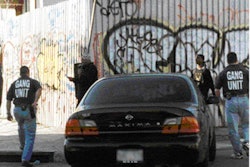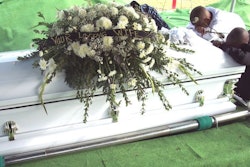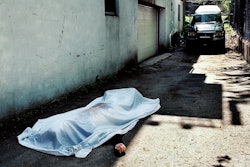I carry a well-worn Smith & Wesson Model 469 semi-auto (9mm), loaded with 13 rounds of Winchester law enforcement ammunition, and I always carry an additional magazine loaded the same way. For me, the weapon is compact enough to carry concealed without giving up too much firepower or knock-down power.
I was a U.S. Army trained MP, "old school," and I prefer the 1911 .45-caliber for duty. But I was required by my department to carry a Beretta 92. So I carried my S&W 469 as my back-up weapon. Counting the two spare Beretta magazines, I carried 58 rounds of 9mm hot hollow-point rounds on my person.
Anybody who ever worked around me in the LASD Prison Gang Unit will tell you I usually had both those weapons holstered and, in my hands, I carried an Ithaca 37 12-gauge, modified by our LASD armorers with a 16-inch barrel and a sawed-down stock.
I carried it loaded with "00" buck rather than the #4 buck because our confrontations with gang members normally occurred at very close range. When I expected trouble, I loaded one in the chamber and four in the tube. Most of our team was armed this way, and we were very proficient with the weapon. Like any other LASD weapon, we were required to qualify with the sawed-off shotguns on the regular shotgun course, including the flying clay targets. Try that with your short shotgun.
In other words, whether I was on duty or off duty, I was going to be prepared to confront and engage gang members (multiple assailants with gunfighting experience), and I expected them to be armed and shooting at me.
I'm addressing this subject because I received feedback from my blog "Paintball Wars: Defending Against Multiple Attackers" where I recommended paintballing as good training for gang cops. Several police firearms trainers expressed the opinion that paintballing was too game-like and unrealistic. These firearms trainers prefer real trigger time on the firing range, running "El Presidente" or other multiple-target drills. I respect their opinions.
In Vietnam, I lead a fire team in house-to-house combat during the 1968 Tet Offensive. As a LASD gang cop, I've engaged Los Angeles gang members in real fire fights and ambushes where multiple shooters brazenly shot multiple rounds intending to kill us. Based on my experience, I'd say my paintball games were more realistic and useful training experiences than any contrived multiple-target drill, falling plates, or even live shoot house.
These scenarios are good, but they are all "set up." You can add running, tactical reloads, and other time stressors to make these drills more realistic. But basically the shooter is expecting the scripted drill and its prescribed actions on his or her part. There can be few surprises. I submit that most armed encounters are unexpected surprise events requiring instant assessment and creative responses to stay alive.
At the police range, a great majority of the firearms training involves only one-on-one training. Even the best live-fire shooting training exercises with multiple cops and targets have one major fault — the static targets don't shoot back. This is so important that almost every nation's basic military training involves the "infiltration course" where live rounds are fired as close as safely possible over the head of the trainees so that they might experience the feeling of incoming fire.
In paintball, multiple adversaries are confronting each other in the mock representations of real combat locations. They all know their targets will shoot back. How exactly that confrontation will occur will be fluid and spontaneous.
The skills of target observation and detection, tactical movement, use of cover and concealment, and functioning as a member of a fire team, are better practiced and learned in these scenarios. All this is reinforced and rewarded when you "survive" and your team wins. When you don't "survive," all your faults and tactical errors will be emphasized with the painful sting of the striking paintballs and the shame of being listed among the "dead."
Your failure to move and use cover is not immediately punished on the police firing range. The static targets can't outflank you. You almost never get the point of view of the barricaded suspect in police shooting scenarios. How do you simulate multiple aggressors moving, shooting and working as a team to take you out? You can't do that on the police range.
Street gangs are just the most well known and familiar example of tactical teams that might confront American law enforcement. Other examples may include active school shooters, motorcycle gangs, Mexican drug and human traffickers, and international terrorists. Every armed professional must practice multiple suspect confrontations. Remember the 1+1 rule — "If you see one target, look for a second; if you see two, look for a third."
One of the best ways to realistically practice armed encounters with multiple suspects is by experiencing the shooting scenarios presented in the fun sport of paintball. If you doubt this, I challenge you to form a group of your police pals, go to the paintball park and divide up into teams. The real gunfighters will soon become evident and your own shortcomings will become painfully obvious.
















